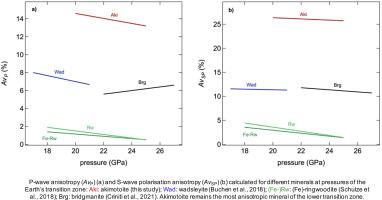Physics of the Earth and Planetary Interiors ( IF 2.4 ) Pub Date : 2021-08-19 , DOI: 10.1016/j.pepi.2021.106786 Nicki C. Siersch 1 , Alexander Kurnosov 1 , Giacomo Criniti 1 , Takayuki Ishii 1 , Tiziana Boffa Ballaran 1 , Daniel J. Frost 1

|
Seismic wave velocities in the Earth's transition zone, between 410 and 660 km depth, are poorly matched by mineralogical models. Mainly due to the presence of majoritic garnet, wave velocities calculated for a peridotite composition lithology are slower than seismic reference models, particularly towards the base of the transition zone. One possible resolution for this discrepancy is if the MgSiO3 polymorph akimotoite replaces majoritic garnet in some regions of the transition zone. This is possible in peridotitic material if temperatures are slightly lower than a typical geotherm or in harzburgitic composition material. The presence of akimotoite might serve as an explanation not only for the discrepancy of seismic velocities at the base of the transition zone but also for observations of transition zone seismic anisotropy in regions of current subduction. In order to provide the data required to test this possibility, two high-quality single-crystals of MgSiO3 akimotoite were studied using combined Brillouin spectroscopy and X-ray diffraction up to 24.86(3) GPa, i.e. to the limit of the akimotoite stability field. The resulting equation of state yields an adiabatic bulk modulus and first pressure derivative of KS0 = 209(2) GPa and K′ = 4.4(1), respectively, and a shear modulus and first pressure derivative of G0 = 131(1) GPa and G′ = 1.7(1). This is in overall agreement with several experimental and computational studies, however, the resulting aggregate velocities are slower than previously reported, especially at high pressures. The elastic anisotropy of akimotoite is found to decrease only slightly with pressure; akimotoite hence remains the most elastically anisotropic mineral in the transition zone and may therefore play a major role in explaining seismic anisotropy observations in the proximity of subducting slabs.
中文翻译:

过渡带压力下MgSiO3 akimotoite的弹性特性和各向异性行为
地球过渡带的地震波速度在 410 至 660 公里深度之间,与矿物学模型的匹配性较差。主要是由于主要石榴石的存在,针对橄榄岩成分岩性计算的波速比地震参考模型慢,特别是在过渡带底部。这种差异的一种可能解决方法是如果 MgSiO 3在过渡带的一些地区,多晶型 akimotoite 取代了主要的石榴石。如果温度略低于典型地热或在橄榄岩材料中,这在橄榄岩材料中是可能的。akimotoite的存在不仅可以解释过渡带底部地震速度的差异,而且可以解释当前俯冲区域过渡带地震各向异性的观测结果。为了提供测试这种可能性所需的数据,两个高质量的 MgSiO 3单晶使用组合布里渊光谱和 X 射线衍射对 akimotoite 进行了研究,最高可达 24.86(3) GPa,即达到 akimotoite 稳定性场的极限。得到的状态方程分别产生K S0 = 209(2) GPa 和K' = 4.4(1)的绝热体积模量和一阶压力导数,以及G 0的剪切模量和一阶压力导数 = 131(1) GPa 和 G' = 1.7(1)。这与几项实验和计算研究完全一致,但是,由此产生的聚合速度比以前报告的要慢,尤其是在高压下。发现 akimotoite 的弹性各向异性随压力仅略微降低;因此 akimotoite 仍然是过渡带中最具弹性的各向异性矿物,因此可能在解释俯冲板块附近的地震各向异性观测中起主要作用。










































 京公网安备 11010802027423号
京公网安备 11010802027423号